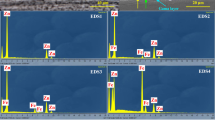Abstract
Cyclic voltammetry, electrochemical impedance spectroscopy (EIS), and galvanodynamic and chronopotentiometric techniques were used to characterize the effects of DXG-F7®, a commercial smoothing agent, on copper electrodeposition onto 316L stainless steel from a synthetic electrolyte containing 40 g/L copper (Cu2+), 160 g/L sulfuric acid (H2SO4) and 20 mg/L chloride (Cl-) at 40oC. The findings were compared against results using HydroStar® 4208, a modified polysaccharide. The nucleation overpotential and plating potential observed in cyclic voltammetry and galvanodynamic testing showed that neither DXG-F7 nor HydroStar significantly polarized acidic copper electrodeposition. Subtle differences between the additives were found during EIS testing and modeling, but more research will be needed to fully understand these differences. Surface-roughness measurements of two-hour deposits indicate that DXG-F7 and HydroStar produced smoother deposits as their concentrations in the electrolyte increased. No difference in the surface roughness of deposits was detected between the additives. Based on the experimental evidence resulting from the laboratory testing, no significant difference was found between DXG-F7 and HydroStar at 20mg/L Cl- concentration, with the exception that DXG-F7 dissolves more easily in water than HydroStar.
Similar content being viewed by others
References
Ashford, B., Clayton, C., and Sandoval, S., 2012, “Improved electrowinning process,” Patent Application No. WO2012051446 A2, 19 April 2012.
Conway, B., Bockris, J., and White, R., 1999, Electrochemical Impedance Spectroscopy and Its Applications in Modern Aspects of Electrochemistry, Kluwer Academic/Plenum.
Fabian, C.P., Ridd, M.J., Sheehan, M.E., and Mandinc, P., 2009, “Modeling the charge-transfer resistance to determine the role of guar and activated polyacrylamide in copper electrodeposition,” Journal of The Electrochemical Society, Vol. 156, No. 10, pp. 400–407.
Gabrielli, C., Mocoteguy, P., Perrot, H., and Zdunek, A., 2003, “Copper interconnects, low-k inter-level dielectrics, and new contact metallurgies/structures,” The Electrochemical Society Proceedings Series, 2003, The Electrochemical Society, Pennington, NJ.
Helsten, T., and Moats, M.S., 2013, “An investigation of modified polysaccharide and polyacrylamide on plating polarization and surface roughness in copper electrowinning,” Copper 2013 Conference Proceedings, Vol. V, Santiago, Chile, IIMCh pp. 235–251.
MacDonald, D., 1977, Transient Techniques in Electrochemistry, Plenum Press.
Moats, M.S., and Derrick, A., 2012, “Investigation of nucleation and plating overpotentials during copper electrowinning using the galvanostatic staircase method,” Electrometallurgy 2012, pp.125–137.
Moats, M.S., Luyima, A., and Oliveria, T., 2014, “Examination of selected copper electrowinning additives,” Proceedings of Hydrometallurgy 2014.
Moats, M.S., Luyima, A., and Cui, W., 2016, “Examination of copper electrowinning smoothing agents. Part I: A review,” Mineral & Metallurgical Processing, Vol. 33, No. 1.
Muresan, L.M., and Varvara, S.C., 2005, “Leveling and brightening mechanisms in metal electrodeposition,” Metal Electrodeposition, Nova Science Publishers, Hauppauge, NY, pp.1–45.
Raja, J., Muralikrishnan, B., and Fu, S., 2002, “Recent advances in separation of roughness, waviness and form,” Precision Engineering, Vol. 26, No. 2, pp. 222–235.
Robinson, T.G., Sole, K.C., Sandoval, S., Moats, M.S., Siegmund, A., and Davenport, W.G., 2013, “Copper electrowinning: 2013 world tankhouse operating data,” Proceedings of Copper 2013 Conference, Vol. V, Book 1, IIMCh, pp. 17–49.
Sandoval, S., Morales, C., and Bernu, C., 2010, “Development and commercialization of modified polysaccharide smoothing agent for copper electrowinning,” SME Annual Conference & Expo 2010, Phoenix, AZ, Society for Mining, Metallurgy and Exploration, Englewood, CO.
Song, S.J.B., and Seok, Y., 2013, “Correlation between internal structure and electrochemical impedance spectroscopy of multiphase slurry systems,” Analytical Chemistry, Vol. 85, pp. 3918–3925.
Sun, M., and O’Keefe, T.J., 1992, “The effect of additives on the nucleation and growth of copper onto stainless steel cathodes,” Metallurgical Transactions B, Vol. 23B, pp. 591–599.
Author information
Authors and Affiliations
Corresponding author
Additional information
Paper number MMP-15-025.
Discussion of this peer-reviewed and approved paper is invited and must be submitted to SME Publications Dept. prior to Aug. 31, 2016.
Rights and permissions
About this article
Cite this article
Luyima, A., Moats, M.S., Cui, W. et al. Examination of copper electrowinning smoothing agents. Part II: Fundamental electrochemical examination of DXG-F7. Mining, Metallurgy & Exploration 33, 14–22 (2016). https://doi.org/10.19150/mmp.6463
Received:
Accepted:
Published:
Issue Date:
DOI: https://doi.org/10.19150/mmp.6463




